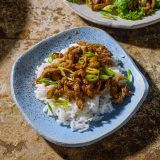High-heat stir-fries are particularly adept at delivering bold flavor in minutes. But for many home cooks, trying to walk the thin line between perfect and overcooked too often results in tough, dried-out meat.
Cooks in China, however, have devised a solution that works with any protein: Use cornstarch. It’s a technique known as velveting. Julienned strips of chicken, pork or beef are marinated briefly, then coated with a thin layer of cornstarch. Usually, the coated protein is seared in very hot oil, and the meat emerges tender with a more luxurious, silky texture.
Bill Leung, who runs the popular blog The Woks of Life with his wife and two daughters, says the benefits of the technique, which seals in the flavors of the marinade, are apparent if one dish is made half with the starch and half without. “What you see is that one will dry out quickly,” says Leung, who grew up cooking in his Cantonese parents’ restaurants. “If you try the other one, it’s this smooth, velvety texture.”
At Milk Street, we’ve found that even lean meats such as beef and pork tenderloin, which are prone to overcooking, end up meltingly tender with this technique. But why? Turns out that the starch absorbs some of the surface moisture from the meat, then quickly gelatinizes when heated in the oil. This provides a barrier around the meat that locks in liquid, making it less likely to overcook.
Inspired by the science, we sought an easy recipe that let it shine through in flavor. We eventually settled on the classic dish jīng jiàng ròu sī, or shredded pork in a savory-sweet sauce enriched with fermented bean paste, or tián miàn jiàng.
Recipes vary, but typically julienned pork tenderloin is marinated in a Shaoxing rice wine mixture. The meat is coated with cornstarch and stir-fried in scalding oil, then removed from the wok. Next, the tián miàn jiàng is cooked with oil and soy sauce. The pork, once returned to the wok, cooks up tender with a sticky glaze. It often is served in moo shu pancakes with sharp scallions that balance the sweet sauce, similar to how Peking duck is presented.
At Milk Street, we streamlined the ingredient list and made some substitutions: Dry sherry gave us a flavor similar to rice wine for the marinade, and hoisin sauce was a reasonable stand-in for the tián miàn jiàng. We also liked how the milder flavor of white pepper paired with the richness of toasted sesame oil.
For convenience, we froze the pork tenderloin briefly to firm the flesh, making it easier to slice. Then we quickly marinated the meat before coating it in the cornstarch and stir-frying it over high heat in a large skillet, browning it to build flavor. The sauce came together quickly and, served with rice, gave our version of jīng jiàng ròu sī all of its varied flavors, with minimal effort.




